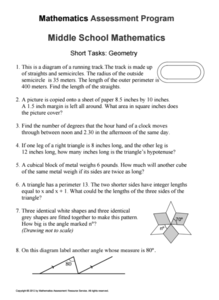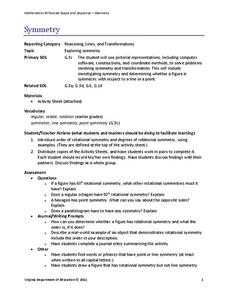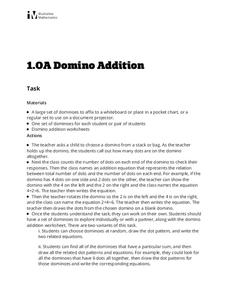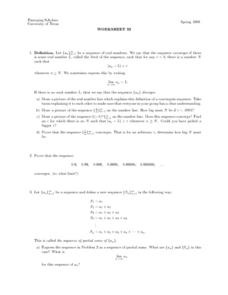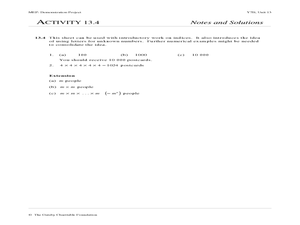Math Mammoth
Grade 1 Worktext
Use graphing, counting, and number lines to help first graders learn about addition and subtraction. An array of worksheets and activities are an excellent resource for your math lesson, whether you are focusing on counting skills or...
California Education Partners
Science Fair Project
Plant the data firmly on the graph. Given information about the growth rate of plants, pupils determine the heights at specific times and graph the data. Using the information, scholars determine whether a statement is true and support...
EngageNY
Logarithms—How Many Digits Do You Need?
Forget your ID number? Your pupils learn to use logarithms to determine the number of digits or characters necessary to create individual ID numbers for all members of a group.
Illustrative Mathematics
The Djinni’s Offer
The djinni in this resource offers gold coins. Learners use the properties of exponents to make their decision as one offer increases exponentially. This makes a great group project. As the commentary suggests, start by having groups...
Mathematics Assessment Project
Geometry
Help learners find joy in facing mathematical challenges. The questions posed on this worksheet encourage young mathematicians to utilize skills learned throughout a geometry unit, and to apply themselves and persevere through problem...
West Contra Costa Unified School District
Solving Inequalities
What does translating points on a number line have to do with solving inequalities? Young mathematicians first learn about translations of points on a number line, and then use this information to solve linear inequalities in one variable.
Concord Consortium
Intersections II
How many intersections can two absolute value functions have? Young scholars consider the question and then develop a set of rules that describe the number of solutions a given system will have. Using the parent function and the standard...
Willow Tree
Factoring Polynomials
Young mathematicians discover trees organize more than just families — they help factor, too. The lesson begins with factor trees and develops slowly to factoring by grouping and special patterns.
Noyce Foundation
Double Down
Double the dog ears, double the fun. Five problems provide increasing challenges with non-linear growth. Topics include dog ears, family trees and population data, and geometric patterns.
Illustrative Mathematics
Gotham City Taxis
Taxi! Have your travelers figure out how far they can go in a taxi for $10.00. They must account for the mileage rate and tip in their calculation. They can set up a table or make an equation to solve for the exact mileage they can...
Balanced Assessment
Books from Andonov
To examine mathematical functions in a modeling situation pupils combine quadratic and step functions to represent a presented scenario. They both graph and write a function to represent data shown in a table.
02 x 02 Worksheets
Symmetry
Get learners' minds rotating and reflecting while looking for symmetry. Pupils investigate figures to determine the number of lines of symmetry and if the figure has rotational symmetry. Classmates work together in groups to find out the...
Curated OER
Domino Addition
Hands-on learning in math is essential to all learners, especially youngsters. In a math learning activity, young mathematicians use dominoes in order to discover the commutative property of addition. Fact families and doubles facts can...
Curated OER
Challenge: Graphing Functions
Here is a functions worksheet in which learners solve functions containing variables, graph the coordinates, and answer two questions about it. They complete 14 functions.
Curated OER
The Algebra of Summation Notation
In this algebra worksheet, learners use the summation notation correctly as they solve problems. They define the integral of a function and solve problems involving i. There are 14 questions with an answer key.
Curated OER
Dividing by 10
Multiplication and division become much easier when mathematicians are dealing with the number 10 as a factor or divisor. Use the examples to get scholars noticing number patterns if they haven't already learned this. They divide 20...
Curated OER
Worksheet 32 - Sequence
For this sequence worksheet, students explain the definition of a convergent sequence and draw models of sequences. This two-page worksheet contains four multi-step problems.
Curated OER
Worksheet 33 - Sequence
In this sequence worksheet, students find the limits of given sequences and prove theorems. This one-page worksheet contains four multi-step problems.
Curated OER
Worksheet 34 - Sequence
In this sequence worksheet, students examine sequences, write the terms of a sequence, identify the limits of a sequence. This one-page worksheet contains seven problems.
Curated OER
Worksheet 6 - Improper Integrals
In this improper integral worksheet, students determine the convergence or divergence of functions. They explore the sequence in the series. This one-page worksheet contains six multi-step problems.
Curated OER
Calculator Patterns 1
For this recognizing patterns using a calculator worksheet, students find recurring decimals to fill in the missing numbers. Students solve 8 problems.
Curated OER
Mental Math Blocks 2
In this math worksheet, students solve eleven math problems. The problems include word problems from a variety of topics, such as money and tickets needed for a concert.
Curated OER
Mental Math Blocks 3
In this math worksheet, young scholars solve eleven math problems. These include finding the missing digits of an addition problem and solving a word problem about picking up pieces of trash.
Curated OER
Searching for Pattern
In these activities with patterns worksheets, students use the rule for 1- or 2- digit number chains, participate in a round robin tournament, identify rhyming patterns and chain letters. Students answer 15 questions.






